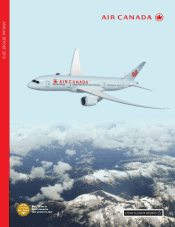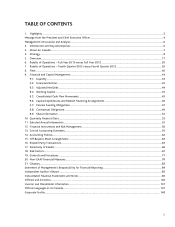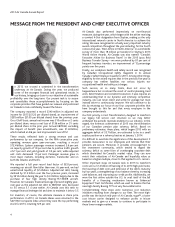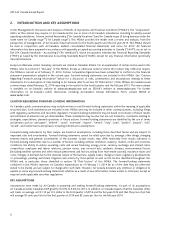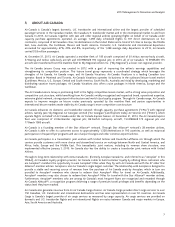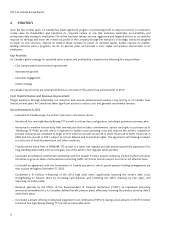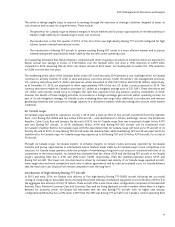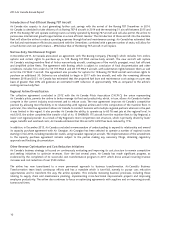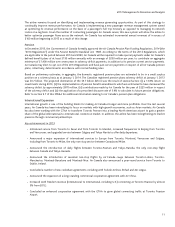Air Canada 2013 Annual Report Download - page 11
Download and view the complete annual report
Please find page 11 of the 2013 Air Canada annual report below. You can navigate through the pages in the report by either clicking on the pages listed below, or by using the keyword search tool below to find specific information within the annual report.
2013 Management’s Discussion and Analysis
11
The airline remains focused on identifying and implementing revenue generating opportunities. As part of this strategy to
continually improve revenue performance, Air Canada is implementing a new passenger revenue management system aimed
at optimizing its revenue performance on the basis of a passenger’s full trip itinerary as opposed to managing its network
routes on a leg basis. Given the number of connecting passengers Air Canada serves, this new system will allow the airline to
better optimize passenger flows across the network. Air Canada has estimated incremental annual revenues of in excess of
$100 million beginning in 2015 as a result of this change.
Pension
In December 2013, the Government of Canada formally approved the Air Canada Pension Plan Funding Regulations, 2014 (the
“2014 Regulations”) under the Pension Benefits Standards Act, 1985. According to the terms of the 2014 Regulations, which
are applicable to the period between 2014 and 2020, Air Canada will be required to make special payments under Air Canada’s
defined benefit plans of at least $150 million annually with an average of $200 million per year, to contribute an aggregate
minimum of $1,400 million over seven years in solvency deficit payments, in addition to its pension current service payments.
Air Canada may elect to opt out of the 2014 Regulations and have past service payments in respect of all Air Canada pension
plans, collectively, determined in accordance with normal funding rules.
Based on preliminary estimates, in aggregate, the domestic registered pension plans are estimated to be in a small surplus
position on a solvency basis as at January 1, 2014. The Canadian registered pension plans solvency deficit at January 1, 2013
was $3.7 billion. The projected elimination of the $3.7 billion deficit was the result of several factors: (i) a 13.8% return on
investments during 2013, (ii) the implementation of pension benefit amendments which are estimated to have decreased the
solvency deficit by approximately $970 million, (iii) contributions made by Air Canada for the year of $225 million in respect
of the solvency deficit and (iv) the application of a prescribed discount rate of 3.9% to calculate its future pension obligations.
Refer to section 9.7 of this MD&A for additional information relating to Air Canada’s pension plan obligations.
International Expansion
International growth is one of the building blocks for making Air Canada stronger and more profitable. Over the last several
years, Air Canada has been intensifying its focus on markets with high growth economies, such as Asian markets. Air Canada
has also been working with the GTAA to transform Toronto Pearson into a leading North American airport to gain a greater
share of the global international-to-international connection market. In addition, the airline has been strengthening its market
presence through commercial partnerships.
Key achievements in 2013
• Introduced service from Toronto to Seoul and from Toronto to Istanbul, increased frequencies to Beijing from Toronto
and Vancouver, and upgraded service between Calgary and Tokyo Narita to offer daily departures.
• Announced a major expansion of international services to Europe from Toronto, Montreal, Vancouver and Calgary,
including from Toronto to Milan, the only non-stop service between Canada and Milan.
• Announced the introduction of daily flights between Toronto-Pearson and Tokyo-Haneda, the only non-stop flight
between Canada and Tokyo-Haneda.
• Announced the introduction of seasonal non-stop flights by Air Canada rouge between Toronto-Lisbon, Toronto-
Manchester, Montreal-Barcelona and Montreal-Nice. Air Canada also announced a year-round service from Toronto to
Dublin, Ireland.
• Concluded a number of new codeshare agreements, including with Turkish Airlines, Etihad and Aer Lingus.
• Announced the expansion of a long-standing commercial cooperation agreement with Air China.
• Increased sixth freedom revenue (international to international, including U.S.) connecting at Toronto Pearson by almost
3% from 2012;
• Concluded an enhanced cooperation agreement with the GTAA to grow global connecting traffic at Toronto Pearson
Airport.

